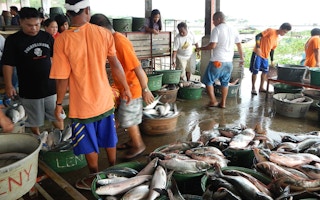The agency responsible for looking after the Philippines’ fish stocks has pledged to step up the science behind its management of the resource as it announced new reforms to the sector.
“Healthy fisheries are critical to the well-being of all Filipinos, and we are committed to making fishing sustainable nationwide,” said Eduardo Gongona, head of the country’s Bureau of Fisheries and Aquatic Resources, in a statement from the Environmental Defense Fund.
Fishermen and women in the Philippines haul in more fish than most other countries on Earth. According to the Food and Agriculture Organization, it ranked 10th in terms of total catch in 2014, when the country’s take was more than 2.35 million metric tons (2.59 million tons). Filipinos consumed 90 percent of fish caught in their country.
“
Healthy fisheries are critical to the well-being of all Filipinos, and we are committed to making fishing sustainable nationwide.
Eduardo Gongona, head, Bureau of Fisheries and Aquatic Resources
That translated to 32.7 kilograms (72.1 pounds) of fish per person in 2011, the 13th-most in the world. At the same time, the island nation’s stocks have been depleted. Some 70 percent of fish populations in the Philippines are overfished, the Environmental Defense Fund says.
That’s why it will work to overhaul its decision-making process by 2022, the country announced at the Our Ocean conference, held Oct. 5 and 6 in St. Julian’s, Malta.
The situation mirrors what many people, especially those in developing countries, face around the world, where fish is often a vital source of protein. The New York City-based Environmental Defense Fund says that 800 million “face direct health risks from declining fish populations.”
That’s why it’s so important to base decisions about this resource on sound information, said Jose Ingles, who advises the Environmental Defense Fund in the Philippines.
“Data, science, participation, and transparency are the foundation for good policy,” Ingles said in the statement. He added that that information would help the Philippines develop a “roadmap” for sustainable fisheries.
Fisheries managers in the Philippines will have access to tools such as FISHE, which stands for Framework for Integrated Stock and Habitat Evaluation.
This tool and others like it from the Environmental Defense Fund help countries that might not have access to the best data to understand how much they’re actually taking from the sea. The goal is then for managers to put policies in place that permit fish populations to come back, while also allowing a sustainable harvest.
“By building our policy reforms on science and investing in reliable enforcement, we can ensure healthy fisheries for the future,” Gogona added.
This story was published with permission from Mongabay.com. Read the full story.










